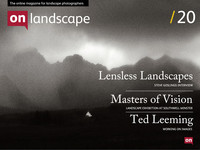Book Review - Terra Borealis, Friedlander & Shoshone Falls

Tim Parkin
Amateur Photographer who plays with big cameras and film when in between digital photographs.
In the past few weeks I’ve been chatting with Beyond Words about reviewing books on a ‘return’ basis (i.e. if I don’t want to keep them I return them, otherwise I pay for them). This looks like it may be turning into an expensive agreement as out of the first three books I’ve ‘borrowed’, I’ve bought two of them.
So briefly which did I borrow and which did I buy. Well the three books borrowed were Lee Friedlander’s “Friedlander”, Marco Paoluzzo’s “Terra Borealis” and Thomas Joshua Cooper’s “Shoshone Falls” (read our interview with Thomas Joshua Cooper) and the only one I returned was Friedlander’s.
Lee Friedlander’s “Friedlander”
Why did I return this book? Well, two reasons - one for me is that his photography is primarly street photography, which doesn’t hold too much interest for me; The second is that although the main reason for borrowing his book is to study and form an opinion on his landscape work, it didn’t move me.
I’ll give you a brief overview or formula for his work. Turn up at a location in the American West; Find a nearby tree, bush or cluttered foreground; Step into the middle of the tree or bush, ensuring that the view you had seen is mostly obscured by it (or compose with the cluttered foreground as a dominant feature); overexpose to demonstrate the intensity of the western light.
To me this seems like the germ of an idea that could prove interesting if developed, but - like many a ‘contemporary’ artist - the throwaway idea seems enough to justify a whole show.
Further, the commentary associated with this set of pictures, although not Friedlander’s, gives you an idea of the mood of the curators at many contemporary institutions (in this case the Museum of Modern Art
“The western landscape was an old [topic] for photography. By the 90’s, indeed, the natural beauty of the West was a distinctly old-fashioned, even questionable theme.”
“The inspiration that the young Ansel Adams had drawn from pristine nature in the ‘20s and ‘30s would henceforth be available only as fraud or self delusion.”
and from the exhibition associated with his landscape work
“The heterogeneous organic mesh so often experienced in the foreground of these landscapes imbue forests and mountains with a kind of intimacy and immediacy ordinarily reserved for those actually trekking through the photographed terrain. The foregrounds do not diminish the power of the hills and mountains but rather draw them into the whole of the rectangular plane, at once veiling and celebrating their volume and shape.”
ho hum...
Marco Paoluzzo’s “Terra Borealis”
Marco Paoluzzo’s “Terra Borealis” is another story. Here is a photographer who is entranced by “the vastness of the place and of the ice”. This is the story of the 60th parallel; a twenty-year project that captured the land, from the prosaic to the sublime. The result is a captivating set of photographs that don’t wander too far into the celebratory or wallow in the despair of the industry defiling the land. These are just a story - images captured to represent a journey. Don’t expect every image to blow you away or to be moved to political activism. And don’t expect magnificent compositions. Do expect to walk away with a feeling that you’ve shared something of the land. That can’t be such a bad thing. One of our readers, David Mantripp, has also reviewed this book which you can read here.
Thomas Joshua Cooper “Shoshone Falls”
Finally, there is Thomas Joshua Cooper’s “Shoshone Falls”. I’ll admit to being perplexed by Mr Cooper. On the one hand, I love some of his work from the ‘Point of No Return’ project - especially the picture “Moonlight” shown to the right.
I’m having difficulty getting into Shoshone Falls though. I’m not sure if it’s just because it is printed so extraordinarily contrasty (enough to give Adams nightmares - “Nooo!! The zones canna take it!!”) or if it’s that it’s over so suddenly (there are only a handful of plates in the book, 18 of Cooper’s and 8 of Sullivan’s).
So why did I buy it? Well - the combination of commentary on Timothy O’Sullivan’s original trip to Shoshone (which inspired the re-photography project) and the contrary nature of Cooper’s prints and his comments in the essay section make for a book I’m sure I will come back to. Will I end up loving it? I don’t know - only time will tell. Will I gain from owning it? Yes I think I probably will - it made me think, which can only be a good thing.
You can buy any of these books from Beyond Words and the links and ISBNs are below.
“Terra Borealis”
Marco Paoluzzo
ISBN: 9783716516386
“Friedlander”
Lee Friedlander
ISBN: 9780870703447
“Shoshone Falls”
Thomas Joshua Cooper
ISBN: 9781934435250





























